The Northeast boasts a wide array of magnificent native trees that comprise the region’s beautiful woods and make compelling additions to our homes’ landscapes and gardens. However, there are also many exotic trees that flourish here as they do in their natural environments. Whether providing something practical (such as a privacy screen) or a more ornamental look (ie. a spring-flowering species), these selections have become reliable-yet-stunning go-tos when creating unique landscapes.
With any planting design, Glengate considers the stewardship of our clients’ properties with the utmost thoughtfulness—especially when it comes to trees. We adhere to the “right plant, right place” ethos that when a plant is installed in the correct location and conditions, it will live happily. Our staff horticulturalists will help guide you in choosing a suitable tree for your landscape based on sunlight, soil and other site requirements. With this in mind, read on to learn about nine of our favorite exotic trees that thrive in the Northeast.
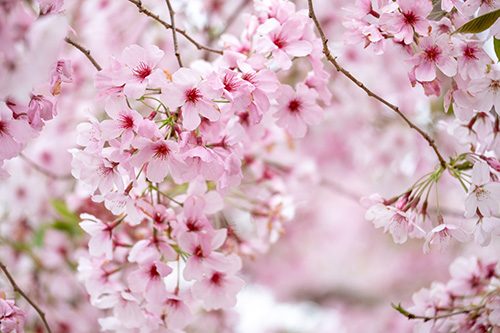
- Cherry tree (Prunus serrulata)
One of the first signs of spring here in the Northeast? The Japanese cherry trees bursting into flower. Their blooming season is relatively short—about two weeks long—but dramatic. And whether planted as a lawn specimen, in a small grouping, or even en masse, the cherry is a charming tree for the home landscape. “Okame,” one of our top cultivars, bursts into deep-pink blooms at the beginning of spring, and its leaves go from bronze-red to bright orange in fall. A newer cherry, “Snow Goose,” is blanketed in showy white blossoms in spring before leafing out. Bonus: the cherry tree is a fairly fast grower.
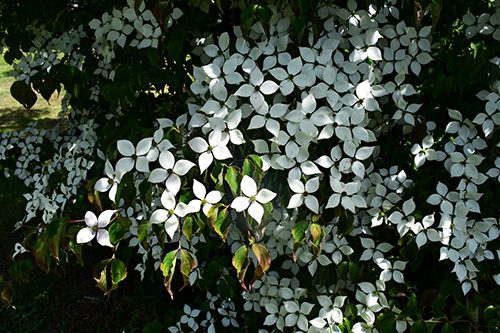
- Kousa dogwood (Cornus kousa)
After our native dogwoods bloom in early spring, you can extend your dogwood “season” with a Kousa, which typically shows its yellow-green blossoms in the Northeast in May. Hailing from East Asia, Kousa is coveted for its year-round interest, turning bright red in fall, and showing off its jigsaw-like bark in winter. A newer hybrid, Cornus x rutgersensis (which crosses the kousa with an American dogwood) exists in several beautiful cultivars that are also less susceptible to pests and disease: “Celestial” flowers heavily with creamy white blooms, while “Aurora” also puts on a fantastic spring show, and grows vigorously.
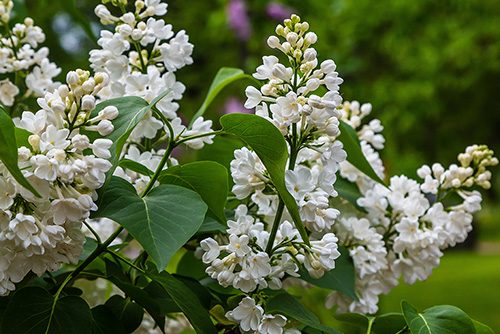
- Seven-Sons Flower (Heptacodium miconionides)
Native to China, this species—a relative of honeysuckle—can be grown as a large shrub or pruned into tree form. While it may be on the smaller side, compared to other trees on our list, its impact is just as spectacular. Heptcafodium flowers in late summer, when other garden favorites are winding down their shows, with fragrant with blooms that attract pollinators (including hummingbirds). Then in fall, small red fruits topped in vibrant pink calyces extend the season before tan bark exfoliates in winter.
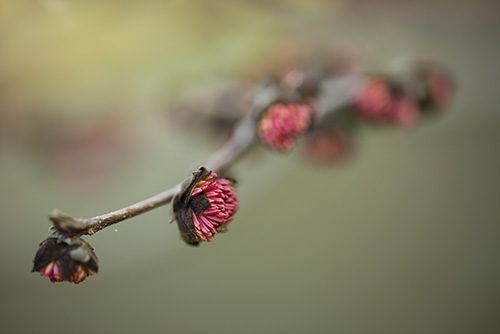
- Persian ironwood (Parrotia persica)
The parrotia, native to Iran, is another year-round stunner: In spring, small red flowers appear on the limbs, and then purple-red leaves open and turn an attractive green in summer. In fall, they go to a spectacular yellow, orange, and red. More mature specimens put on a winter show of exfoliating bark. The tree’s tolerance for varying landscape conditions make it an even more desirable pick. Look for the cultivars ‘Kew’s Weeping’ (it has an umbrella shape), ‘Persian Spire’, and ‘Vanessa’ (which grows in an upright, columnar form).
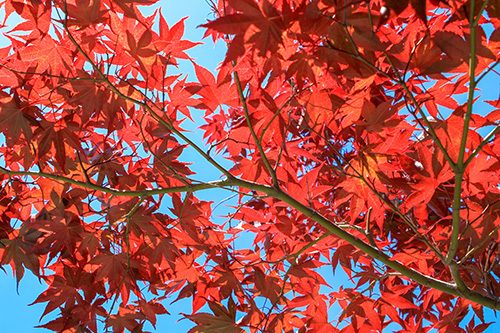
- Japanese Maple (Acer palmatum)
There are over 1,000 cultivars of Japanese maples, making this species extremely adaptable to a wide range of landscape sizes and styles. Cultivars that have proven hardy in the Northeast include ‘Bloodgood’ (its burgundy leaves go scarlet in the fall), ‘Crimson Queen,’ a weeping dwarf tree that can also be used in containers, and ‘Viridis,’ valued for its delicately cut foliage that turns a golden hue in fall. (‘Viridis’ can be potted, too.) Japanese maples are also more shade tolerant, making them a good option for the north side of a house, or adding color to a less-sunny spot in the garden.
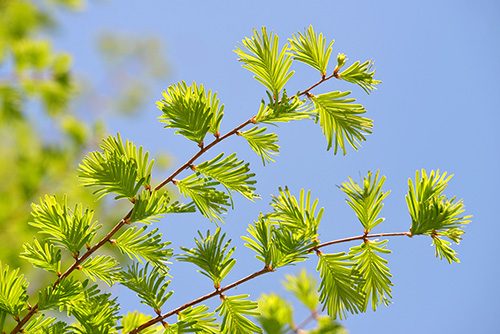
- Dawn redwood (Metasequoia glyptostroboides)
Native to central and western China, the dawn redwood doesn’t get as tall as its enormous cousins on the west coast of the U.S. (those can reach over 300 feet!). But it does still grow very fast and get very big—up to about 125 feet. This makes the Dawn redwood, a deciduous conifer, an extraordinary specimen tree for large open spaces. Though, one cultivar, ‘Gold Rush,’ reaches 50 feet tall and has an upright habit, so it’s more appropriate for a medium sized space.
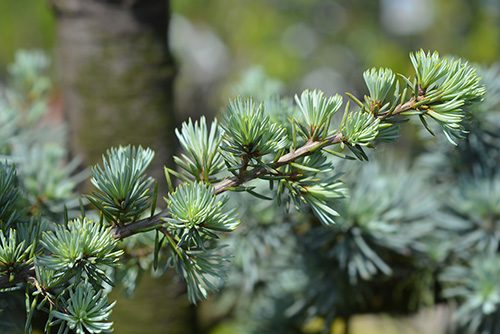
- Atlas Cedar (Cedrus atlantica)
The Atlas cedar, which is endemic to mountainous regions of Morocco and Algeria, is valued in residential landscapes for its silver-blue foliage and distinctive branches. The evergreen conifer is also quite drought tolerant when established. It’s a versatile species, with cultivars to enhance a property in various ways: the species tree, reaching heights of 60 feet or more, and the weeping ‘penula’ options make beautiful specimen trees; while the ‘Horstmann’ cultivar stays small and can be utilized as a foundation planting.
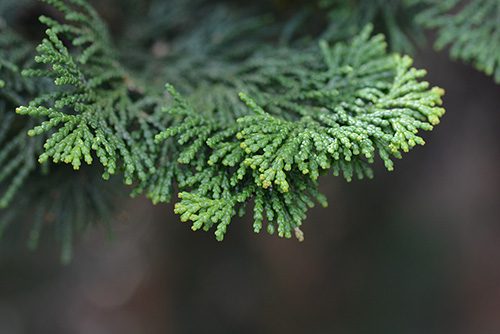
- Hinoki cypress (Chamaecyparis obtusa) ‘Gracilis’
Not only does the Hinoki cypress endure the Northeast’s cold winter temperatures, it’s also drought tolerant and will grow in not-ideal soil. If that weren’t enough, this native of central Japan boasts beautiful bright-green, textured foliage that grows in dense, undulating shapes. Hinokis are often placed at the corners of a house, and do elegantly frame a structure. Just be aware: though they are slow growing, some cultivars of these graceful trees grow quite tall (over 40 feet). For smaller options look to dwarfs such as ‘Nana Gracilis.’
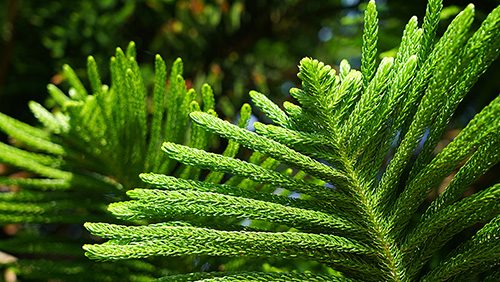
- Cryptomeria (Cryptomeria japonica)
Another Japanese evergreen, the cryptomeria, is fast growing and low maintenance, making it the perfect privacy tree. It is striking when multiples of its kind are planted together as a screen, and just as eye catching mixed in with other tall dense evergreens (think Serbian spruce or Thuja Green Giant). The cultivar ‘Yoshino’ is a very attractive choice. One thing to note: this species is not always suitable for higher elevations or very cold climates; though it can be a wonderful selection for landscapes closer to the coast.



